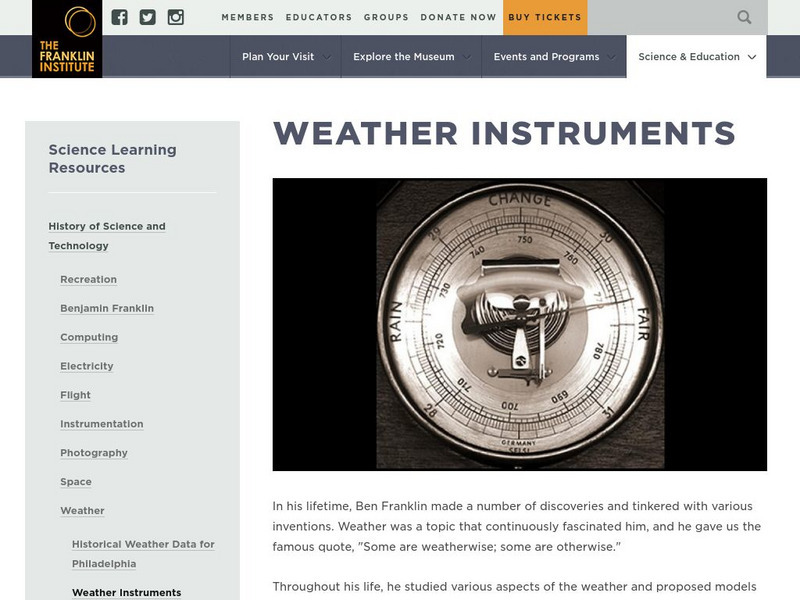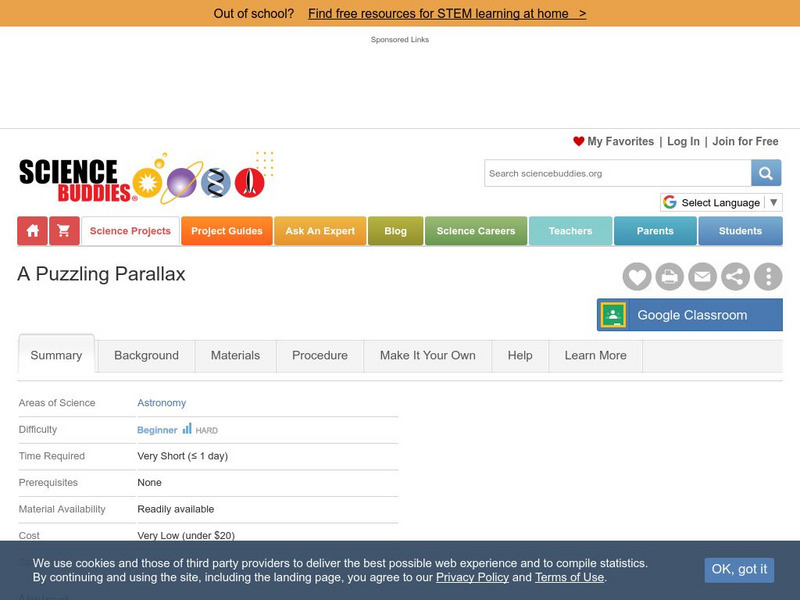Canada Science and Technology Museum
Canada Science and Technology Museum: Background Information for Sound
Sound! How does it work? All you need to know about it is found here through a series of Q&As. Educators will find useful lesson plans.
The Franklin Institute
Franklin Institute: History of Science and Technology: Weather Instruments
A look back in time at weather instruments used in previous centuries. Includes pictures and descriptions of instruments from Franklin Institute's historical collection.
Science Buddies
Science Buddies: A Puzzling Parallax
Did you know that ancient astronomers could measure the distance to other stars? They could also distinguish between stars and planets. How could they do that without modern technology of telescopes? See if you can discover the link...
Science Buddies
Science Buddies: Effects of Food Preservatives on the Growth of Microorganisms
The problem of protecting food from spoilage has been with us since prehistoric times. The solutions to this problem have changed with advances in technology and knowledge about what causes food to spoil. This project uses liquid...
Society for Science and the Public
Science News for Students: Concussion: More Than 'Getting Your Bell Rung'
This article explains the science of concussions, including the damage they can do to the brain and symptoms of concussion. The article also describes the technology that scientists are using to detect concussion and how helmets are now...
Alabama Learning Exchange
Alex: Using Primary Sources
This is an interdisciplinary inquiry-based instructional activity that focuses on critical thinking. Students are introduced to the true story of the first Thanksgiving with the reading of a NCSS Notable Trade Book Thanksgiving: The True...
Alabama Learning Exchange
Alex: Researching Hurricanes With Technology
This lesson will help students to understand the formation, power, and history of hurricanes. Students will do this using a combination of technological skills. Examples of technology used include: PowerPoint, Word, Netscape Composer,...
American Geosciences Institute
American Geosciences Institute: Earth Science Week: Exploring 'Wild' Places With Gis
This lesson plans uses Geographic information systems (GIS) technology to explore the local geography.
American Geosciences Institute
American Geosciences Institute: Earth Science Week: Mapping Quake Risk
Students use GIS to observe worldwide patterns of earthquakes and volcanoes and analyze the relationships of those patterns to tectonic plate boundaries. Then they identify cities at risk.
Alabama Learning Exchange
Alex: Organism Power Points/ Booklets
This lesson requires students to use technology to research information on any organism from one of the six kingdoms. Students use the information to produce a PowerPoint presentation or booklet to present to their classmates. This...
Society for Science and the Public
Science News for Students: New Waves for Safe Flying
Discusses technology being used to improve airport security in the wake of the terrorist attacks in recent years. [Date of Article: April 28, 2010]
Society for Science and the Public
Science News for Students: These Gems Make Their Own Way
Discusses past efforts to make artificial gemstones, the different methods used to make them today, and possible applications for this technology. (Date of article: May 25, 2010)
National Academies of Sciences, Engineering, and Medicine
The National Academies: Understanding Efficiency
This interactive activity from the The National Academies of Sciences examines the ways that improved energy efficiency can be achieved at home and on the road. Compare technology in both settings, and understand their energy...
Technovation
Curiosity Machine: Challenges: Build a Self Propelling Boat
Use this site to plan, document, and build a self-propelling boat that can travel a set distance. Students will use common materials to build this boat.
Technovation
Curiosity Machine: Challenges: Build a Buoyant Catamaran
Could you use plastic bottles, popsicle sticks, and tape to Engineer a catamaran that can hold 15 ounces of cargo without sinking? Use this site for lesson plans, tips, and a place to document your process.
Technovation
Curiosity Machine: Challenges: Engineer a Speedboat
This challenge has students using a zip line to guide a boat to move through the water for long distances. To help the students build a fast and steady boat this site contains a lesson plan as well as tips. Students can also document...
Technovation
Curiosity Machine: Challenges: Design a Wind Up Mars Rover
Using common household items, students are challenged to build a Mars rover that can travel using elastic energy. Site includes a lesson plan, tips, and a place for students to document their design process.
Technovation
Curiosity Machine: Challenges: Engineer a Space Tool
Using common household items, make a tool that an astronaut could use to pick up an object in space. This site also includes tips, lesson plans, and a place for students to document their engineering design process.
Technovation
Curiosity Machine: Challenges: Balance a Dinosaur
Using common household items, students are challenged to build a dinosaur at least 6" tall that can balance on two legs using counterbalances. This website contains the challenge, tips, a lesson plan, and a place for students to document...
Technovation
Curiosity Machine: Challenges: Make a Signal Horn
Build a signal horn to make low-frequency sounds that can be heard from far away in this STEM lesson. Use this interactive site to document your design process. Included on the site is a video explaining a possible solution to the problem.
Technovation
Curiosity Machine: Challenge: Build a Blooming Flower
Can you create a blooming flower that would attract pollinators? This Curiosity Machine project challenges students to make this flower using common household items. Site includes a place for students to document their process as well as...
Technovation
Curiosity Machine: Challenges: Build a Dinosaur Shadow Box
Create a series of shadow boxes to form a complete silhouette of a dinosaur with this challenge. To complete this challenge, students will use everyday materials and this site to document their process.
Technovation
Curiosity Machine: Challenges: Engineer a Pneumatic Creature
Create a creature that uses air to create motion with this challenge. Site includes tips, lesson plans, and a place for students to document their design process.
Technovation
Curiosity Machine: Challenges: Make a Pine Cone
Using cardboard, popsicle sticks, rubber bands, and strings create a pine cone that opens and closes. This site contains lesson plans, tips, and a place for students to document their engineering design process.












